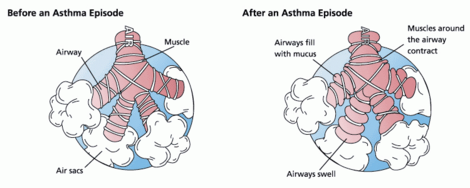- Jangan sesekali mengkhianati perasaan hati kamu kerana akibatnya, hanya kamu yang akan sengsara; bukan orang lain. Salah satu cabaran paling sukar dalam hidup ialah mencari orang yang tahu segala kelemahan dan kekurangan diri kamu, tetapi dia masih sangup menyayangi dan mencintai kamu dengan sepenuh hatinya.
- Hiduplah dengan cinta! Tetapi bukan bererti cinta buta. Kita dapat mencintai hidup dengan lebih baik, yaitu cintailah sekelilingmu, baik yang ada diluar dirimu atau didalam dirimu.
- Cinta pandang pertama adalah cinta yang akan kekal abadi
Latihan di Kem PULADA

Friday, July 18, 2008
Madah Cinta
Asthma
Asthma is a chronic condition involving the respiratory system in which the airways occasionally constrict, become inflamed, and are lined with excessive amounts of mucus, often in response to one or more triggers. These episodes may be triggered by such things as exposure to an environmental stimulant such as an allergen, environmental tobacco smoke, cold or warm air, perfume, pet dander, moist air, exercise or exertion, or emotional stress. In children, the most common triggers are viral illnesses such as those that cause the common cold.
This airway narrowing causes symptoms such as wheezing, shortness of breath, chest tightness, and coughing. The airway constriction responds to bronchodilators. Between episodes, most patients feel well but can have mild symptoms and they may remain short of breath after exercise for longer periods of time than the unaffected individual. The symptoms of asthma, which can range from mild to life threatening, can usually be controlled with a combination of drugs and environmental changes.
Pathophysiology
In asthma, constriction of the airways occurs due to bronchoconstriction and bronchial inflammation. Bronchoconstriction is the narrowing of the airways in the lungs due to the tightening of surrounding smooth muscle. Bronchial inflammation also causes narrowing due to oedema and swelling caused by an immune response to allergens.

Inflamed airways and bronchoconstriction in asthma. Airways narrowed as a result of the inflammatory response cause wheezing.
Emergency
When an asthma attack is unresponsive to a patient's usual medication, other treatments are available to the physician or hospital:
- Oxygen to alleviate the hypoxia (but not the asthma itself) that results from extreme asthma attacks.
- Nebulized salbutamol terbutaline (short-acting beta-2-agonists), often combined with ipratropium (an anticholinergic).
- Systemic steroids, oral or intravenous (prednisone, prednisolone, methylprednisolone, dexamethasone, or hydrocortisone). Some research has looked into an alternative inhaled route.
- Other bronchodilators that are occasionally effective when the usual drugs fail:
- Intravenous salbutamol
- Nonspecific beta-agonists, injected or inhaled (epinephrine, isoetharine, isoproterenol, metaproterenol)
- Anticholinergics, IV or nebulized, with systemic effects (glycopyrrolate, atropine, ipratropium)
- Methylxanthines (theophylline, aminophylline)
- Inhalation anesthetics that have a bronchodilatory effect (isoflurane, halothane, enflurane)
- The dissociative anaesthetic ketamine, often used in endotracheal tube induction
- Magnesium sulfate, intravenous
- Intubation and mechanical ventilation, for patients in or approaching respiratory arrest.
- Heliox, a mixture of helium and oxygen, may be used in a hospital setting. It has a more laminar flow than ambient air and moves more easily through constricted airways.
Epidemiology
Asthma is usually diagnosed in childhood. The risk factors for asthma include:
- A personal or family history of asthma or atopy
- Triggers (see Pathophysiology above)
- Premature birth or low birth weight
- Viral respiratory infection in early childhood
- Maternal smoking
- Being male, for asthma in prepubertal children
- Being female, for persistence of asthma into adulthood
History
- Asthma was long considered a psychosomatic disease, and
- ... during the 1930s–50s, was even known as one of the 'holy seven' psychosomatic illnesses. At that time, psychoanalytic theories described the aetiology of asthma as psychological, with treatment often primarily involving psychoanalysis and other 'talking cures'. As the asthmatic wheeze was interpreted as the child's suppressed cry for his or her mother, psychoanalysts viewed the treatment of depression as especially important for individuals with asthma







No comments:
Post a Comment